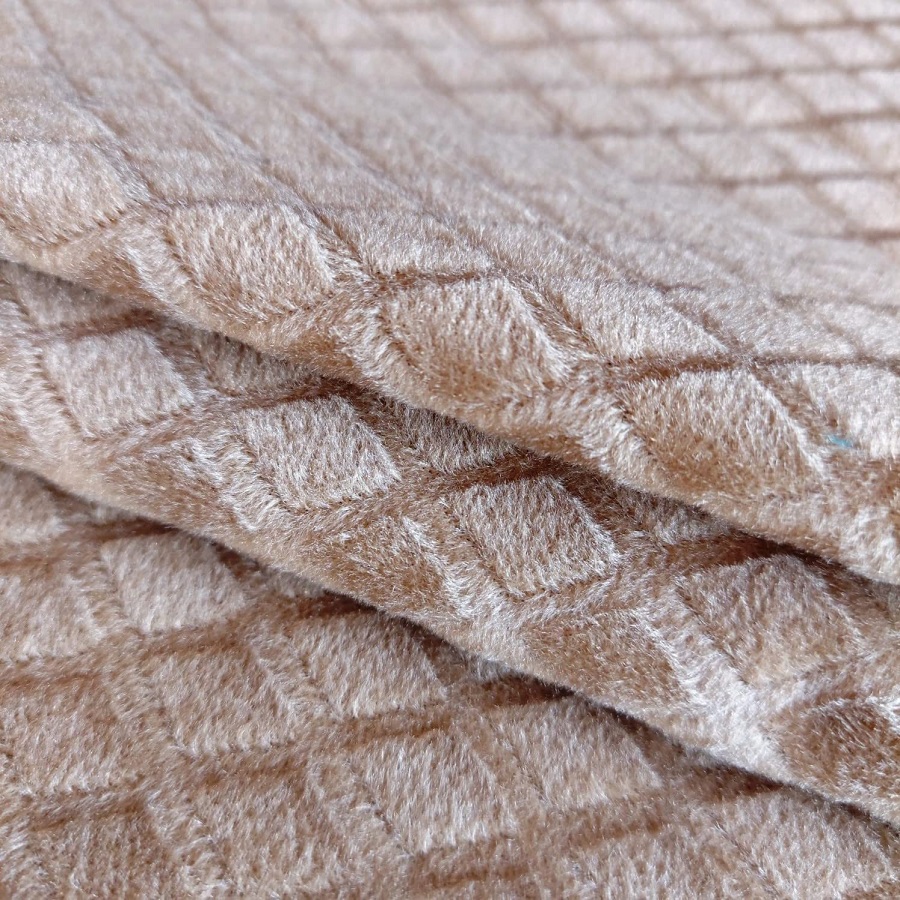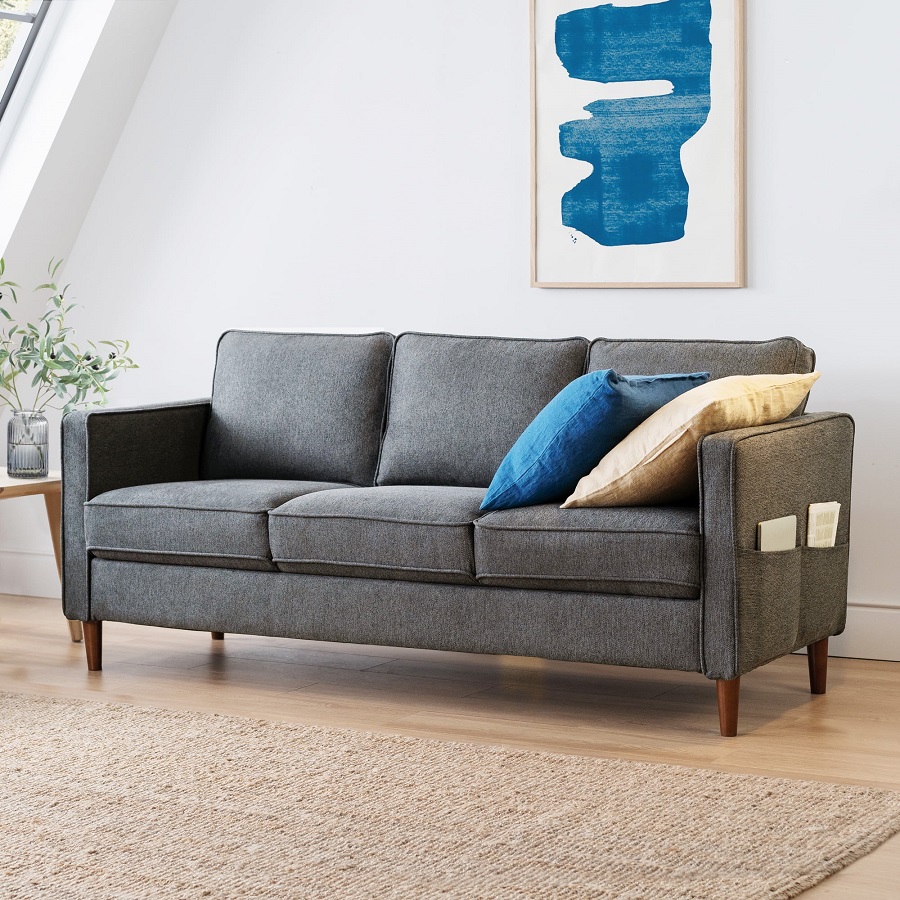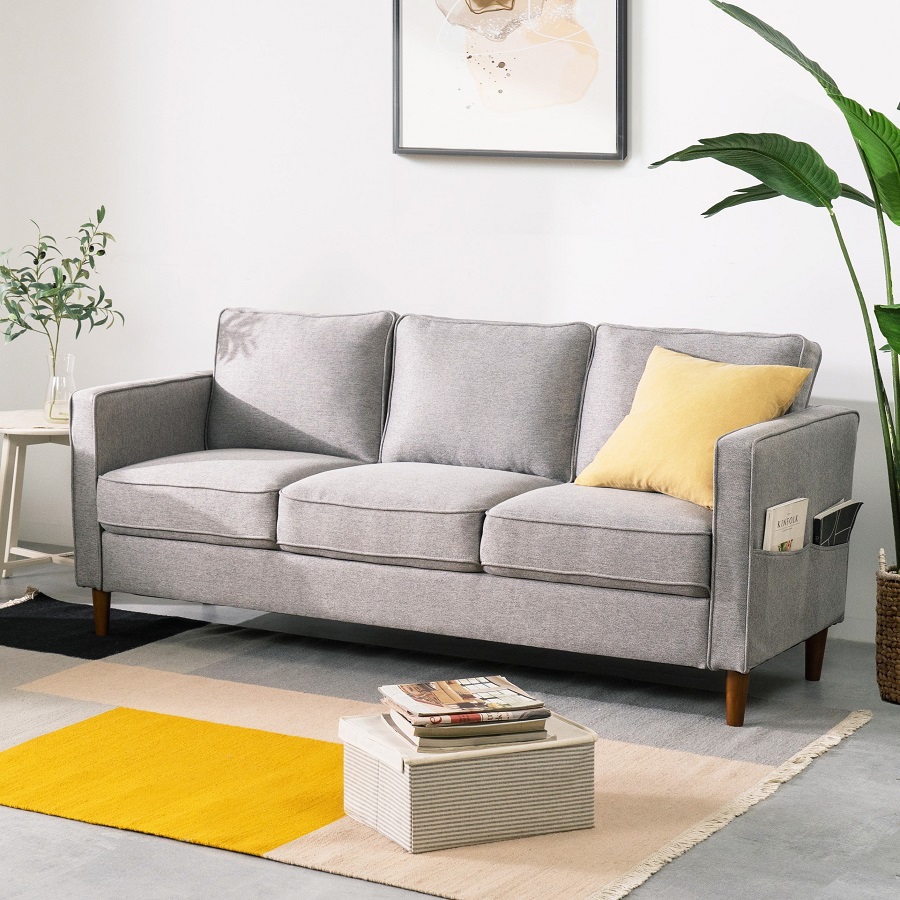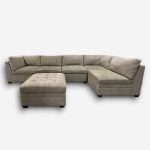Identifying Your Sofa’s Fabric Type
Identifying the type of fabric on your sofa is essential before cleaning. Not all sofas are the same, and knowing your sofa’s fabric type will help you choose the right cleaning method. Here’s how to determine what fabric you’re dealing with:
- Check the Sofa’s Label or Documentation: Most sofas come with a label or documents that list the fabric type.
- Natural Fabrics: These may include cotton, linen, or wool. They often require special care.
- Synthetic Fabrics: Common synthetic materials include polyester, nylon, or microfiber. They usually withstand more vigorous cleaning techniques.
- Blended Fabrics: Some sofas feature a mix of natural and synthetic fibers. Blended fabrics can offer the best of both worlds but pay attention to care instructions.
- Perform a Touch Test: Feel the texture of the fabric. Natural fibers tend to be cooler to the touch than synthetic ones.
Knowing your sofa’s fabric type is the first step in effective sofa cleaning. It guides you in selecting the correct cleaning solutions and methods, ensuring your sofa’s longevity and appearance.

Understanding Cleaning Codes for Your Sofa
Every sofa comes with a manufacturer’s cleaning code, which you must check before attempting to clean. This code will tell you exactly what kind of cleaning agents you can safely use on your sofa’s fabric without causing damage. Here are the most common cleaning codes:
- W: This code means that you can use water-based cleaning solutions on your sofa.
- S: Solvents are the only safe cleaning agents to use for sofas with this code.
- WS: Both water-based cleaners and solvents are okay for these fabrics.
- X: Vacuuming or light brushing only; water and solvent cleaners are not suitable.
By adhering to these codes, you protect your sofa and ensure that it gets cleaned effectively. Always remember to perform a spot test on a hidden part of the sofa, regardless of the cleaning code, to prevent any unexpected damage. Starting from identifying the correct methods to routine clean-ups and choosing the appropriate supplies, these codes are your roadmap to maintaining your sofa’s look and feel.
Essential Cleaning Tools and Supplies
To keep your fabric sofa in top condition, having the right tools is crucial. Here’s what you’ll need:
- Vacuum with Upholstery Attachment: This is for regular dust and debris removal.
- Soft-Bristle Brush: Helps loosen surface dirt and tackle debris stuck in fabric crevices.
- Microfiber Cloths: These cloths are gentle on fabric and great for blotting and wiping.
- Mild Dish Soap: Acts as a gentle cleaner for water-safe sofa fabrics.
- Baking Soda: A natural deodorizer that’s good for light cleaning and removing odors.
- Enzyme-Based Cleaner: Specifically targets organic stains like food or pet accidents.
- White Vinegar: Handy for DIY cleaning solutions, especially when mixed with water.
- Cleaning Sprays: Use sprays appropriate for your sofa’s fabric type and cleaning code.
- Upholstery Cleaner Machine: Useful for deep cleaning, especially on large or stubborn stains.
- Rubbing Alcohol or Solvent: Needed for sofas with ‘S’ cleaning codes.
Remember to always test any cleaner on a small, inconspicuous area of your sofa first. Keep these tools in a handy place, so you’re prepared for routine maintenance or any unexpected spills. Proper cleaning supplies not only preserve your sofa’s appearance but also prolong its life.
Regular Maintenance: Vacuuming and Cushion Care
Keeping your fabric sofa clean involves regular maintenance.
- Routine Vacuuming: This is your first line of defense. Use your vacuum’s upholstery attachment to remove dust, dirt, and crumbs. Do this weekly to maintain the fabric’s appearance and prevent buildup.
- Cushion Flipping and Rotating: This helps to distribute wear evenly. Flip and rotate sofa cushions every month. It helps to maintain their shape and comfort over time.
- Spot Vacuuming: Pay extra attention to crevices and under cushions. Use your vacuum’s crevice tool to reach these areas where crumbs and pet hair collect.
- Brushing: A soft-bristle brush can loosen any stubborn dirt stuck in the fabric. Do this gently to avoid damaging the sofa’s fibers.
- Wiping Down: Use a slightly damp microfiber cloth to wipe the surfaces. It can refresh the fabric without using harsh chemicals.
- Protection Measures: Consider using sofa covers or throws. They can protect against spills and can be washed easily. This can be especially helpful if you have children or pets.
Remembering these simple steps for vacuuming and cushion care can greatly extend the life of your sofa. It keeps the fabric fresh and reduces the need for deep cleaning.

Spot-Cleaning Techniques for Common Stains
When faced with stains on your fabric sofa, quick and effective action is necessary. Here are some spot-cleaning methods to tackle common stains on your upholstery:
- Food and Drink Spills: Gently blot the spill with a clean, dry microfiber cloth. Then, apply a mixture of warm water and mild dish soap with a new cloth.
- Pet Stains: Clean with a specialized enzyme-based cleaner designed for pet stains. Blot the affected area with the cleaner, then rinse with water.
- Ink Marks: Dab the area with a cloth dipped in isopropyl alcohol. Do not rub, to avoid spreading the stain.
- Grease Stains: Sprinkle baking soda on the stain and let it sit before vacuuming it up. For stubborn grease, apply a dry-cleaning solvent as per the fabric’s cleaning code.
Always test any cleaning solution on a small, hidden section of the sofa. Follow the cleaning code for ‘W’, ‘S’, ‘WS’, or ‘X’ labeled on your sofa to avoid damage. Deal with stains as they happen to prevent them from setting in and becoming harder to remove.
Deep Cleaning Your Sofa with Baking Soda
Deep cleaning a fabric sofa can seem daunting. However, baking soda, a safe and effective household item, can do wonders. Here’s a simple guide to deep cleaning your sofa using baking soda:
- Step 1: Sprinkle Baking Soda: Distribute baking soda lightly across the sofa. Ensure even coverage.
- Step 2: Let It Sit: Allow the baking soda to sit for about 20 to 30 minutes.
- Step 3: Vacuum It Up: Use the upholstery attachment on your vacuum to clean off the baking soda.
This process helps to deodorize and lift light stains from the sofa’s fabric. It is especially good for sofas safe with water (Code ‘W’). Remember, the goal is to use just enough to cover the sofa lightly. Too much can clog your vacuum. Always do a spot test in a hidden area to prevent fabric damage.
For tougher stains, make a paste using baking soda and water. Apply the paste to the stain, gently rub with a cloth, then let it dry. Once dry, vacuum away the residue. This method can be particularly effective on grease or oil stains.
Regular use of baking soda can keep your sofa smelling fresh and clean. It’s economical, convenient, and gentle on most fabrics. Combine it with routine vacuuming and your sofa will look well-kept for years to come.
Using Commercial Cleaners and Shampoo Machines
Choosing commercial cleaners for your sofa requires careful consideration. Here are steps for using them:
- Select the Right Cleaner: Match the cleaner to your sofa’s fabric type and cleaning code.
- Read Instructions: Always follow the product’s user guide for the best results.
- Test a Small Area: Apply the cleaner to a hidden part of your sofa to check for colorfastness.
- Use Shampoo Machines: For deep cleaning, rent or purchase a shampoo machine.
- Fill Machine with Cleaner: Add the appropriate cleaning solution as indicated.
- Operate Machine Carefully: Move the machine over the sofa’s surface, ensuring even coverage. Do not over-wet the fabric.
- Rinse if Required: Some machines have rinse cycles. Use this feature if your sofa’s fabric allows.
- Dry Your Sofa: Allow adequate air circulation for the sofa to dry completely. Use fans to speed up the process.
Using these tools can make your fabric sofa look rejuvenated. However, ensure to always use them per your sofa’s specific requirements and fabric type.
Professional Cleaning Versus DIY: Pros and Cons
When deciding between professional sofa cleaning and DIY, consider these points.
Pros of Professional Cleaning
- Deep Cleaning: Professionals bring expertise and equipment that offer a deeper clean than most DIY methods.
- Time-Saving: Hiring experts saves you a significant amount of time and effort.
- Longevity: Professional cleaning can extend your sofa’s life by using the right techniques and solutions.
- Guaranteed Results: Professionals often guarantee their work, ensuring customer satisfaction.
Cons of Professional Cleaning
- Cost: Professional cleaning services come with a higher price tag compared to DIY.
- Availability: Scheduling can be limited, and you may need to align with the cleaner’s timetable.
- Chemical Use: Some services may use stronger chemicals that you prefer not to have in your home.
Pros of DIY Cleaning
- Cost-Effective: DIY cleaning is generally less expensive as you’re doing the labor yourself.
- Control: You select the cleaning products, allowing control over the chemicals used.
- Convenience: You can clean on your own schedule without waiting for an appointment.
Cons of DIY Cleaning
- Less Effective: Without professional equipment, DIY may not be as thorough.
- Time Consuming: DIY takes time and effort, which can be a drawback for busy individuals.
- Risk of Damage: Incorrect cleaning methods may damage the sofa fabric.
Consider these pros and cons when choosing between professional and DIY sofa cleaning.
Long-Term Sofa Care Tips
Ensuring your fabric sofa remains in prime condition requires consistent effort. Here are long-term care tips to follow:
- Use Throws and Slipcovers: Protect your sofa from spills and stains with throws. Easily washable, they can be a quick fix to décor and hygiene.
- Avoid Direct Sunlight: Position your sofa away from windows where direct sunlight can fade and weaken fabric.
- Rotate Seating: Encourage even wear by rotating your favored seating spot.
- Clean Spills Quickly: Address spills immediately to prevent permanent stains. Blot, don’t rub, to avoid fabric damage.
- Ban Food and Drinks: If possible, keep food and drinks away from your sofa to minimize accidents.
- Restrict Pet Access: If pets are allowed, use pet covers or set rules to limit their impact on the upholstery.
- Regular Professional Cleaning: Schedule a professional cleaning annually to maintain upholstery health and appearance.
- Avoid DIY Experiments: Stick to proven cleaning methods. Risky DIY mixes can cause fabric damage.
- Ventilation: Keep your living space well-ventilated. It helps the fabric stay fresh and dry.
- Follow Manufacturer’s Advice: Always heed the cleaning instructions provided by your sofa’s manufacturer.
By mastering these sofa care tactics, you can enjoy a clean, comfortable, and stylish sofa for years.

When to Call in the Professionals: Signs Your Sofa Needs Expert Attention
Sometimes, despite our best efforts, a DIY approach to sofa cleaning falls short. It’s essential to recognize when to call in professional help to ensure your sofa is properly taken care of. Here are some signs that your sofa may need expert attention:
- Persistent Stains: If repeated spot-cleaning efforts don’t remove a stain, professionals can help.
- Extensive Wear and Tear: Professionals can revitalize sofas showing signs of significant use.
- Bad Odor: When unpleasant smells persist even after deep cleaning, it’s time for professional help.
- Allergic Reactions: If cleaning doesn’t resolve allergy symptoms, deep cleaning by experts may be necessary.
- Major Spills or Accidents: For large or complex spills, professional services ensure thorough cleaning.
- Manufacturer’s Recommendation: Follow guidelines suggesting professional cleaning for optimal care.
- Time Constraints: If you lack the time for detailed cleaning, experts can efficiently handle the job.
Professional cleaners bring advanced equipment and techniques that can address these issues effectively. By entrusting your sofa to professionals when needed, you prolong its life and ensure a clean, healthy environment in your home.


